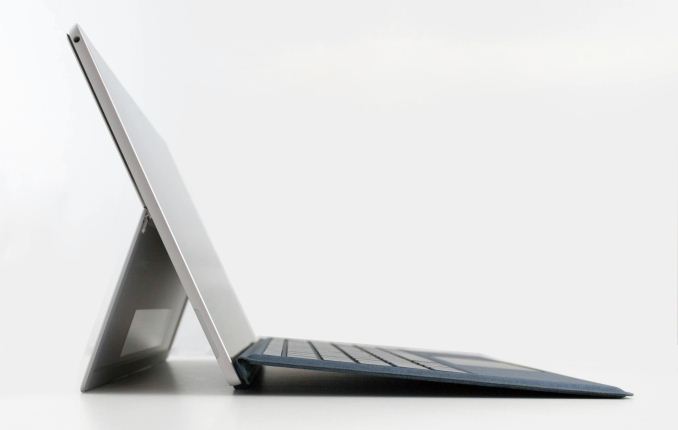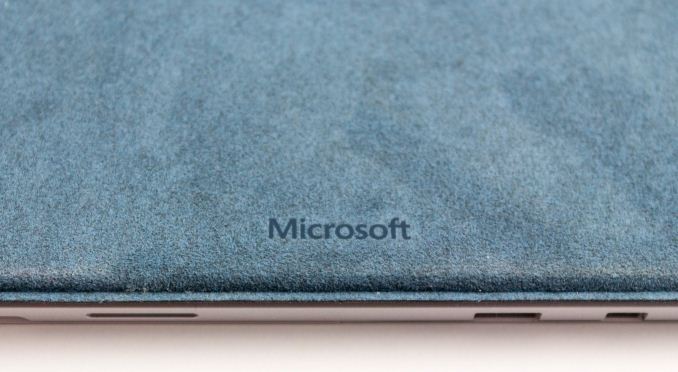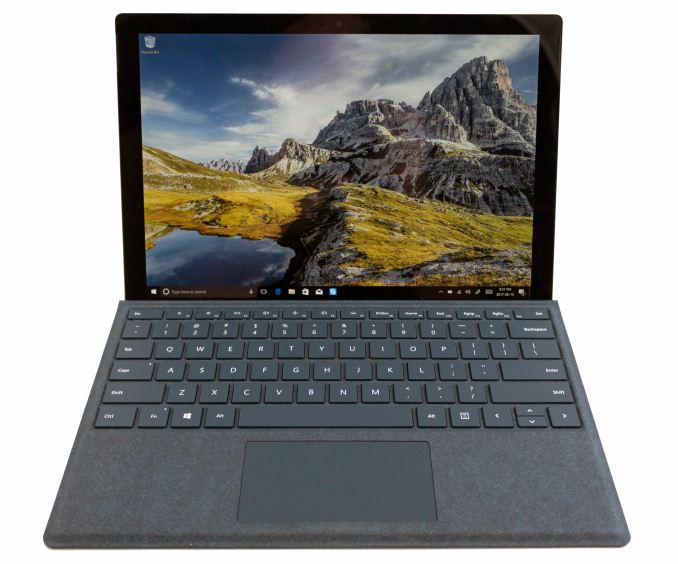The Microsoft Surface Pro (2017) Review: Evolution
by Brett Howse on June 15, 2017 9:00 AM ESTFinal Words
The Surface Pro lineup has always been one of the most powerful tablet class devices around. Microsoft is no longer marketing it as a tablet that can replace your laptop anymore though, and they’ve acknowledged that most of the customers who buy and use the Surface Pro are looking for an ultraportable laptop. That makes a lot of sense, since the Surface Pro weighs only 786 grams / 1.73 lbs for the Core i5 and i7 models, and the Signature Type Cover only adds another 310 grams / 0.68 lbs. As a complete package, it’s only 1.096 Kg / 2.41 lbs. It’s not the lightest device around, but it’s still very light and easy transport.
Packing a full 15 Watt U series Intel Core processor into such a small package has been a challenge in the past, but with improvements to both the cooling and the heat output of the CPU over the last couple of generations, it’s no longer the problem it once was. The CPU is able to run at full power in the new Surface Pro without throttling, although the new power modes will throttle it by default. This allows the Surface Pro to run almost silently for almost any task, yet still offer more processing speed than the outgoing model.
The design of the Surace Pro is mostly unchanged, if you consider the size, weight, and thickness. But the new design is softer in the hand, with rounded edges where the old models were more angular, and it is immediately noticeable when you pick it up. Surface Pro didn’t need a full redesign at all, so the small touches have done a great job without messing with what made Surface Pro so popular in the first place.
The display changes follow the same theme. It’s still the same size, and resolution, but the new display now features an “Enhanced sRGB” mode which brings a bit more vibrancy to the colors, without affecting skin tones. For color critical work, there’s still the sRGB mode, which has amazing color accuracy, but for those that are willing to sacrifice accuracy for a bit more punch, the new Surface Pro delivers that. And even in Enhanced sRGB mode, the average error level is still better than many machines on the market.
Battery life has also improved, mostly thanks to a larger capacity battery, but the new Kaby Lake chip likely helps as well. Surface Pro will always lag the best Ultrabooks in battery life, because it can’t compete on outright capacity, but Microsoft has done a great job again with platform efficiency.
The I/O port situation is not ideal, and here Microsoft seems to be taking a stand against USB-C and Thunderbolt 3, to the detriment of its customers. Offering the full-size USB port that is on there now is, without a doubt, the correct decision to make. But it seems like wasted space to offer a mini DisplayPort connecter over a USB-C port which could easily handle DisplayPort duties (and so much more). USB-C is a bit of a mess, with different ports providing different alt-mode functionality, and that will continue to be a problem, but it would have been great to see a fully capable USB-C port with Thunderbolt 3 for future connectivity. Intel has announced that they will be building more of that into their SoCs soon, so that would open the door to allowing this in future Surface Pro models without having to add extra chips on the motherboard.
Surface Pro’s accessories have always played a key role in its success, and the new Signature Type Cover with Alcantara fabric is very nice to use. Hopefully the polyurethane coating will increase durability as well. It’s available in three colors to match the Arc Mouse, and the new Surface Pen.
The Surface Pen improvements are surprisingly impressive. The existing pen on the Surface Pro 4, Book, and Studio, were all good quality digital pens, offering replaceable tips, and a fantastic traction on the display, but the new version really brings it to a new level. The sensitivity is quadrupled, from 1024 levels, to 4096, and the actuation force is decreased from 20 grams to just 9 grams, plus the new pen now supports tilt. The latency has also been reduced to just 21 ms, and from testing it out, it’s amazing how you can’t easily get the pen ahead of the ink now, where there was always a small lag before.
Microsoft didn’t need to revolutionize the Surface Pro, and rather than mess with what’s worked, they’ve continued to refine it. A softer design, a wider opening kickstand, and better accessories all bring the Surface Pro ahead of the pack again. Even after being on the market since November 2015, the Surface Pro 4 was arguably still the best product in this category, and the 2017 Surface Pro extends that lead.
Pricing makes the Surface Pro competitive, with a starting price of $799 for the Core m3 model with 4 GB of RAM and a 128 GB SSD. The base model is likely just to get people in the door though, and the Core i5 model with 8 GB of RAM and a 256 GB SSD is likely the sweet spot, although it bumps the price up to $1299. The review model, with a Core i7, 16 GB of memory, and a 512 GB SSD creeps up to $2199, and the 1TB model is $2699. These prices don’t include the keyboard cover, which starts at $129.99 for the normal version, and goes up to $159.99 for the Signature edition. Compared to the Surface Pro 4, the prices are practically identical with looking at the launch prices, although the Core m3 model is $100 less expensive. The Surface Pen used to be included though, so overall, there’s a $60 price increase for most models if you used the pen. For an Ultrabook, its entry price is right in-line with the competition.














124 Comments
View All Comments
skavi - Thursday, June 15, 2017 - link
They have a coating on the fabric to prevent the worst of wear. If you've touched it, it feels a bit more rubbery than expected based on appearance.BrokenCrayons - Thursday, June 15, 2017 - link
Since the keyboards are easily detached and can be replaced independently of the rest of the tablet, wear and tear might not be a problem as long as you can get your hands on a new one after it starts looking ragged. I know that's not an ideal solution, but it shouldn't discourage purchase of one of these things for those people that still have an interest in buying a tablet in modern times.BillBear - Thursday, June 15, 2017 - link
For $130 apiece, you think they are disposable?fanofanand - Thursday, June 15, 2017 - link
It is an odd position for BrokenCrayons to make, as he is typically a proponent of less waste and spending less on tech. To each their own but this seems to be very inconsistent with his previous posts. I think $2600 is absurd for what you get.BrokenCrayons - Friday, June 16, 2017 - link
My justification is based on the purchase price of the Surface Pro. The price is fairly high relative to the hardware specs and suffers from limits in utility due to its tablet form factor. For someone making that sort of purchase for personal use, I'll go out on a limb to argue that there are emotional and social implications (ex: desire for a status symbol, brand loyalty to Microsoft, etc.) that override practical considerations and therefore the cost of a replacement keyboard is probably a less significant factor than the need to have one that looks fresh and new. In short, this is about the psychology of the buyer which doesn't have a lot to do with my personal preference to use borderline derelict laptops for my own computing needs.Eliadbu - Friday, June 16, 2017 - link
Just buy Eve-V why pay excessive amount of money for a brand.simard57 - Wednesday, June 21, 2017 - link
has the Eve-V been reviewed here at AT?simard57 - Wednesday, June 21, 2017 - link
if HP, Dell or Lenovo offered a 3:2 display - I would seriously consider it.I would lean towards the 360 models. I wonder why Microsoft didn't make the Surface Laptop a 360 model 2-1. are there serious compromises required to support a 360 hinge over a traditional clam shell laptop?
desolation0 - Thursday, June 15, 2017 - link
The $130 version does not include the Alcantara fabric, but also seems to stick with basic black for color scheme. It is not available yet, but is listed on the Microsoft Store. The Alcantara sheathed signature edition cost $160. If you are more worried about durability and a bit of savings than feel and style the regular edition would be your cover of choice. On the subject of durability and replaceability, it should be noted that the keyboard parts for most ultrabooks and laptops are available significantly cheaper. Unfortunately, for many ultrabooks and some laptops the replacement process can be prohibitively difficult for the average consumer. Professional repair service can run you as much or more if you don't shop around successfully.name99 - Thursday, June 15, 2017 - link
Why the insistence on these sorts of very thin "cover" keyboards? Seems like painting yourself into a corner.For iPad you can use a separate bluetooth keyboard (eg the same Apple wireless keyboard that you can use with an iMac) and just carry that with you, along with a very lightweight cover that also acts as a stand (like the Apple cover and a thousand other covers). I assume Surface can also use a BT keyboard.
This pair doesn't look like a laptop anymore, if anything it's more like using an iMac. But it does mean you don't have to force all the compromises and constant weight of a super thin keyboard. It also means that (depending on your exact usage patterns) you can leave the keyboard at home, or in your hotel room, or whatever, and use the on-screen keyboard for small messages, just switching to the real keyboard when you need to type a lot.
Seems to me a better alternative for most users --- but most people seem unaware of it. Even in the Apple store, they were clueless when I explained this to them --- I had to actually demo pairing an Apple keyboard with an iPad before they believed me!
People are just locked into this mental image of "make it look+feel like a laptop" even though that's not necessary.